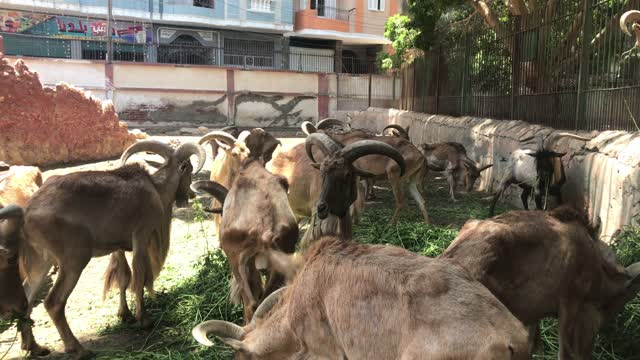Premium Only Content

Barbary Sheep in the Zoo
The Barbary sheep or aoudad is a species of caprid native to rocky mountains in North Africa. Six subspecies have been described. Although it is rare in its native North Africa, it has been introduced to North America, southern Europe, and elsewhere. It is also known in the Berber language as awdad, waddan, arwi, and arrwis.
Barbary sheep stand 80 to 100 cm (2.6 to 3.3 ft) tall at the shoulder and weigh 40 to 140 kg (88 to 309 lb). They are sandy-brown, darkening with age, with a slightly lighter underbelly and a darker line along the back. Upper parts and the outer parts of the legs are a uniform reddish brown or grayish brown. There is some shaggy hair on the throat (extending down to the chest in males) and a sparse mane. Their horns have a triangular cross section. The horns curve outward, backward, then inward, and can exceed 40 inches in length. The horns are fairly smooth, with slight wrinkles evident at the base as the animal matures.
Barbary sheep naturally occur in northern Africa in Algeria, Tunisia, northern Chad, Egypt, Libya, northern Mali, Mauritania, Morocco, Niger and Sudan (west of the Nile, and in the Red Sea Hills east of the Nile).
Barbary sheep have been introduced to southeastern Spain, the southwestern United States (Chinati Mountains on La Escalera Ranch, Guadalupe Mountains National Park, Palo Duro Canyon, the Trans-Pecos, and other parts of Texas, New Mexico, and California), Niihau Island (Hawaii), Mexico, and some parts of Africa.[citation needed]
They have become common in a limited region of south-eastern Spain, since its introduction in 1970 to Sierra Espuña [Regional park] as a game species. Its adaptability enabled it to colonise nearby areas quickly, and private game estates provided other centers of dispersion. The species is currently expanding, according to recent field surveys, now being found in the provinces of Alicante, Almería, Granada, and Murcia.This species is a potential competitor to native ungulates inhabiting the Iberian Peninsula. The species has also been introduced to La Palma (Canary Islands), and has spread throughout the northern and central parts of the island, where it is a serious threat to endemic vegetation.
-
 0:23
0:23
Beautiful_Animals_And_Birds
5 years agoBunny Born With No Ears
247 -
 1:12:40
1:12:40
Adam Does Movies
6 hours ago $1.71 earnedThe Best & Most Overrated Christmas Movies - LIVE!
20.9K2 -
 9:09:04
9:09:04
BubbaSZN
9 hours ago🔴 LIVE - SLAYING ZOMBIES W/ CATDOG UNTIL MY BDAY AT 12AM!
24.4K6 -
 4:47:55
4:47:55
SlingerGames
6 hours agoRumble Spartans, ASSEMBLE! | Push for 400 Followers
16.6K2 -
 5:22:07
5:22:07
xXFadedAngelXx
9 hours agoSPARTAN NIGHT! Featuring the Communiy! Thanks @OhHiMark! & @Phyxicx! for the invite
28.3K1 -

AdmiralSmoothrod
8 hours agohalo MCC - Multiplayer Rumble No. 21 - its gonna get sticky
16.7K3 -
 1:35:22
1:35:22
BlackDiamondGunsandGear
6 hours agoNEW Glock Gen6 / Still Hate them / After Hours Armory
11K2 -
 8:49
8:49
Hollywood Exposed
7 hours agoBill Maher Explodes After Killer Mike Refuses Any Accountability On Air
8.31K13 -
 1:35:22
1:35:22
DLDAfterDark
7 hours ago $0.99 earnedThe Average Gunfighter - Gen 6 Glocks - The After Hours Armory
6.49K -
 12:31
12:31
Robbi On The Record
2 days ago $9.60 earnedWhy Nothing Feels Real Anymore | The Science, Culture, and Spiritual War Behind the Fog
68.1K32